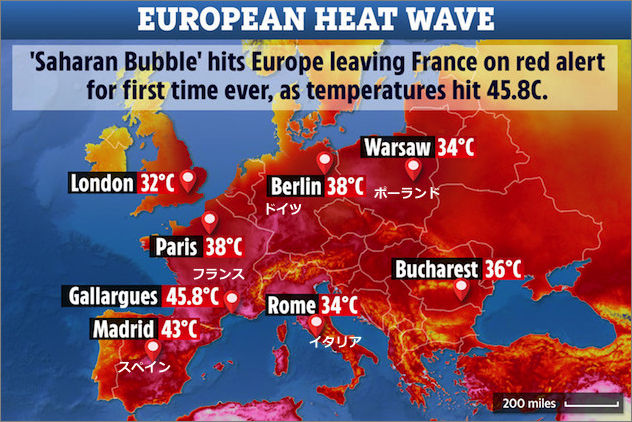
How will global climate change affect the quality and price of whisky?
共有
In Japan, where there are four distinct seasons - spring, summer, autumn, and winter - it is normal to think that in summer, hot days in mid-summer are ordinary, and that cold days in mid-winter are natural because it is winter. The occasional cool summer day or warm winter day is probably only thought of as a lucky day out, except for farmers.

However, in recent years, intense changes in the global climate and the prevalence of extreme weather upheavals have surprised the Japanese, who are very familiar to the four distinct seasons and are insensitive regular changes in the climate, because of their suddenness and violence. In summer in particular, climate changes so drastically that the word ‘capricious’ is not enough to describe it: with guerrilla downpours, hailstorms, severe thunderstorms, and tornadoes - something different from the weather I have known in Japan.

Furthermore, the heat wave in Europe seems to be effecting not only damage to crops and changes in rainfall patterns, but also changes in the quality of the land. I remember watching on the news that the European bloc was in turmoil, experiencing temperatures exceeding 40 degrees Celsius (104 degrees Fahrenheit), with a maximum of 46 degrees Celsius (114.8 degrees Fahrenheit), and drought and flooding at the same time. Each time I would think to myself, ‘Oh, local barley production will plummet.’ In fact, I could confirm samples from one area in Europe where annual barley production has decreased by as much as 40% due to climate change and other factors.
Hence, global climate change, which is progressing faster than mankind had anticipated, is already having a destructive impact on industry and life, and I believe that the global whisky industry will face a considerable crisis soon. Whisky will be treated as more of a luxury than it is now, and it will cost more to produce and consume whisky than it does now. I am just another whisky lover, not an expert, but I think the following are inevitably going to happen:
1) Significant reduction in barley production and quality due to climate change

The factor with the most direct and destructive impact on the industry is the decline in the production and quality of barley used in whisky production. As mentioned earlier, many barley farms have seen their production plummet by 40% or more due to rapid climate change in recent years, and this trend is expected to continue.
In an interview in 2023, Asahi Group Chairman Katsuki, of Asahi Beer fame, stated that, ‘Under the UN's worst-case scenario, in which global temperatures rise by 4 degrees Celsius by 2050, 18% of France's barley supply would be reduced.’ If the 2-degree-Celsius warming specified in the Paris Agreement takes place, the supply could decrease by 10%, and in the case of Poland and the Czech Republic, which are two leading beer-producing countries, a rise of just 4 degrees Celsius could reduce barley supplies by 15% and 25%, respectively.
Alongside this increase in the cost of growing barley, the quality of the barley itself will decline and the cost of producing whisky will increase rapidly. Even though the whisky to be bottled in a decade will be made from barley harvested around 2020 or earlier, the higher production costs within ten years will be directly reflected in the price of whisky ten years later.
2) Increased condemnation and social costs for grain liquor production against a background of global food shortages

You might think, ‘Such a thing is indeed unlikely!’ but the social demands and pressures for a sustainable economic environment are getting stronger each day, regardless of the business sector. The continuous growth of the world's population in recent years, wars, military conflicts, and climate change, which have resulted in reduced harvests and food production capacity, could lead to medium- to long-term global famine. In this context, even the raising of livestock that feed on grain is beginning to be socially condemned, and in time, the condemnation of the processing of grains such as barley and corn into alcohol rather than into a meal will probably intensify.
Many Scotch whisky distilleries are now increasing new investment in sustainable operations. Glengoyne Distillery, for instance, has developed a recycling system whereby the distillery's effluent is purified by wetland plants, and the purified water is managed and used again by installing a wetland facility that traps carbon dioxide. The creation of this wetland has also improved biodiversity by providing a haven for local wildlife, including 14,500 plants of 20 different species and 80,000 bees.
Another, the Tomartin distillery, was also named sustainable distillery of the year at the 2023 Icons of Whisky awards, where it converted the fuel required for whisky production from traditional fuels to biomass energy and liquefied natural gas, and, like Glengoyne, created a wetland to help improve biodiversity alongside a system that purifies the plant's treated water, even generating solar power to reduce their carbon footprint.
Other distilleries will be forced to invest more than ever before in developing sustainable systems, but where will the huge costs come from? Naturally, it will be added to the price of the whisky sold. This means that the price of whisky in the future will have to be continually higher, and in the case of long-aged whisky, it may no longer be a price that appeals to the eye.
3) Depletion of fine natural resources used in the production of whisky maturing casks

Currently, whisky operations in Scotland generally utilize casks made from European oak wood. Although the consumption of wood gives the impression of destruction of nature, manufacturers there do not contribute to global environmental problems because they develop and harvest forest resources at the same time. The problem, however, is not an environmental one, but the decline in the production and quality of the wood resources used in oak casks for maturing whisky.
- Emissions action of oak casks:Oak casks expel volatile aromatic substances (aldehydes), lipids, tannins, lactones, and other components.
- Absorption action of oak casks:The charred interior of casks acts as a carbon filter and absorbs the ingredients of the whisky.
- Interaction between oak cask and whisky:The interaction between oak cask and whisky paves way to the creation of new substances after an exchange of constituent substances between the cask and whisky.
- Oxidizing action of whisky:Evaporation and oxidative action result from the fact that oak casks are not fully sealed.
Whisky is matured as described above, whereby the components of the cask develop a chemical reaction with the whisky to nurture its flavor. However, changes in wood composition due to climate change and longer growing periods of wood have made it increasingly difficult to secure high quality oak casks for making good tasting whisky.
Furthermore, the distribution of distinctive casks such as wine and cognac casks for maturing whisky has been drastically reduced because of the fall of the European wine industry. This has led to a decline in the number of high-quality oak casks that used to hold fine wines, greatly reducing the choices of casks in which to age whisky.
As a consequence, the production costs of high quality, long-aged whisky may rise by a factor of two in the future, and whisky in general with a stated age, rather than 18 years old, may become an unaffordable luxury product.
4) Increased burden for greenhouse gases generated during whisky distillation

Whisky production is widely associated with the image of steam rising from huge distillation vessels in distillation facilities. There are various distillation methods for making whisky, but the traditional upstream methods, according to whisky manufacturers, is being evacuated as an ‘environmentally destructive practice for a rich man's hobby’ because the process emits particularly more heat and carbon dioxide than modern gas distillers. So, it seems that these days, distilleries are forced to install state-of-the-art management equipment and systems that measure and control the amount of carbon dioxide emitted. They must build new facilities that absorb carbon dioxide, and pay a hefty burden for their greenhouse gas emissions. All these costs will definitely effect an increase in the price of whisky.
5) Increased costs of securing peat (deet and peat)

Most of the peat extracted by the entire UK industry is used for general fuel use, and only 1% goes to whisky production. Due in part to the high amount of peat used for general fuel use, peat reserves are visibly declining, and the Scottish government has announced that it will invest £250 million to restore 250,000 hectares of peatland by 2030. Although this huge investment money is a government expenditure, ultimately the burden will have to be passed on to the whisky industry.
For the above reasons, I feel that the future whisky market is likely to be further divided into low-priced whisky and high-priced whisky, with high-quality whisky that can be examined over time becoming a hard-to-find luxury product. Because of this, getting your hands on the whiskies that you like as soon as possible may be the best way to go.
